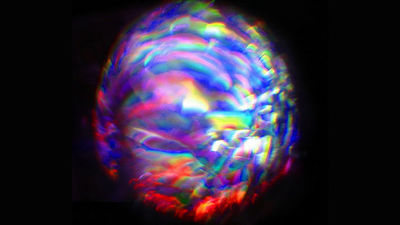Four common misunderstandings about quantum mechanics such as the fate of 'Schrodinger's cat'

Even if you have never studied quantum mechanics in a specialized way, if you have ever been interested in mysterious phenomena peculiar to the field of quantum mechanics, such as '
Four common misconceptions about quantum physics
https://theconversation.com/four-common-misconceptions-about-quantum-physics-192062
Misconception 1: Cats can be alive or dead
Austrian physicist Erwin Schrödinger wrote in 1935, 'Put a bottle of poison gas in a box with a cat so that the bottle would crack when the Geiger counter reacted with radioactive material that decays with a 50% chance. I advocated the thought experiment 'to do'. In this case, it is not possible to tell from outside the box whether the radioactive material has decayed and the cat inside is dead. coexisting with”.
The first time this superposition phenomenon was observed was in the famous double-slit experiment .

by Alexandre Gondran
In this experiment, when one photon passes through two slits, instead of a point where the particles hit each other behind the slit, a striped pattern is created by the interference of the two waves. From this result, the conclusion was drawn that light is both a photon (particle) and a wave, and that the photon's location is not determined until it is observed, but this cannot be explained by conventional physics. No, it's counter-intuitive. Schrödinger's cat was devised to point out this oddity.
This phenomenon of “superposition” of various states is observed even for objects larger than a photon. In 1999, Austrian quantum physicist Anton Zeiringer demonstrated that quantum superposition can also occur in
Then, does a cat, which is much larger than a buckyball, overlap the state of being alive and being dead? This is because, in order for something like the double-slit experiment to occur, the photons passing through the two slits must have the property of interfering with each other as waves, in other words, they must be coherent . Because the coherence of an infinite number of atoms is very short-lived.
This doesn't mean that living things can't be coherent, it just means that the laws of quantum mechanics don't generally apply to large objects like cats and humans, Malik and his colleagues explain. did.

Misconception 2: Quantum entanglement can be explained with a simple analogy
Quantum entanglement is a quantum property that binds two different particles together, so that measuring one of the particles in this state automatically and instantly changes the state of the other particle, no matter how far apart it is. I understand.
Common explanations of quantum entanglement include familiar objects in the classical macro world, similar to Schrödinger's cat. For example, put a blue card and an orange card in separate envelopes, shuffle them, and give one to a friend. And if your friend opens the envelope and a blue card comes out, you know that the contents of the envelope you have is an orange card.
This explanation is intuitively convincing, but the problem is that there is a phenomenon called superposition in the world of quantum mechanics. The superposition of the cards means that the cards in the envelope are both blue and orange. However, even in that case, when one envelope is opened, a card of a different color always comes out from the other envelope. This strange link is the identity of quantum entanglement.
Albert Einstein, famous for his theory of relativity, was not convinced by this phenomenon. This is because the theory of relativity does not recognize the existence of anything that exceeds light, but in quantum entanglement, the state of separated quanta is instantly known, and it is as if communication is being carried out between quanta at a speed that exceeds the speed of light. Because it looks like Therefore, Einstein intuitively explained quantum entanglement with classical physics, and thought that there is a 'hidden variable' in the card that cannot be directly observed, and that this determines the color of the card. claimed.

Einstein's claim has been denied by
In this way, quantum entanglement cannot be simply explained, so Professor Malik and others commented, ``When thinking about quantum entanglement, forget about everyday things.''
Misunderstanding 3: The world does not exist
Bell's theorem is often described as proving that 'nature is not local'. For example, the aforementioned phenomenon of quantum entanglement is 'non-local' in the sense that it does not matter how far apart it is. It is also often interpreted that the properties of quantum mechanical objects are 'unreal', meaning that they do not exist prior to measurement.
However, to say that 'nature is unrealistic and nonlocal' according to Bell's theorem, we need to make various assumptions at the same time. These assumptions include that there is only one measurement, that cause and effect flow forward in time, and that the world is not a pre-determined ' clockwork universe '. increase.
In other words, we cannot say that nature is real and local unless we deny common-sense empirical rules such as the flow of time. It is unreasonable to claim that it is flowing in the opposite direction. Therefore, it is expected that further research in the future will narrow down the various interpretations proposed in the field of quantum mechanics.

Misconception 4: No one understands quantum mechanics
Physicists Richard Feynman and Niels Bohr, both of whom have made significant contributions to the field of quantum mechanics, said, 'If you think you understand quantum mechanics, you don't understand quantum mechanics.' It is said that he left the words
Indeed, it seems that no one can understand quantum mechanics, which even Einstein could not convince. However, according to Professor Malik and others, quantum physics is not particularly difficult mathematically. For example, superposition and quantum entanglement do not require high school mathematics if we use the term quantum information , and Bell's theorem can be derived in a few lines using probability theory and linear algebra instead of quantum physics. .
The real challenge lies in reconciling quantum physics with the intuitive real world. Nonetheless, even if quantum mechanics is not completely elucidated, quantum technology such as quantum computers will continue to advance.
At the end, Professor Malik and others said, ``Fortunately, there are people who keep asking 'why,' like the three scientists who won the Nobel Prize in Physics in 2022. People may be able to combine the strange quantum world and the real world.'
Related Posts:
in Science, Posted by log1l_ks







